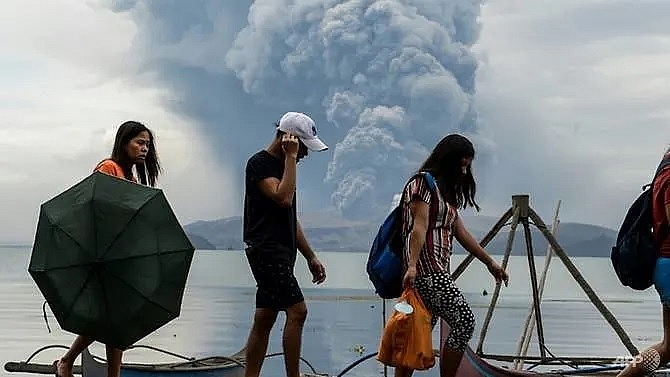Thousands face uncertainty as Philippine volcano spews lava
 |
| Many residents abandoned livestock and pets as well as homes full of belongings after authorities warned that an 'explosive eruption' could come imminently AFP/Ted ALJIBE |
The crater of the volcano exploded to life with towering clouds of ash and jets of red-hot lava on Sunday, forcing those living around the mountain south of Manila to flee to safety.
Many residents abandoned livestock and pets as well as homes full of belongings after authorities sounded an alert warning that an "explosive eruption" could come imminently.
About 30,000 are currently in shelters.
Gerald Aseoche, 30, fled with his four young children and a few possessions, and has refused to leave them to go to work as the volcano belches out lava and earthquakes tied to the eruption rattle the region.
"I am hoping this won't go on too long because I will lose my job if I can't report to work immediately," Aseoche, a house painter, told AFP at an evacuation centre.
"I can't leave them ... family first," he said as he cradled one of his children.
Taal is one of the most active volcanoes in a nation hit periodically by eruptions and earthquakes due to its location on the Pacific "Ring of Fire" - a zone of intense seismic activity.
The Taal eruption has been putting on a stunning and terrifying display, with lightning crackling through its ash cloud in a poorly understood phenomenon that has been attributed to static electricity.
ERUPTIONS HAVE LASTED MONTHS
Renato Solidum, head of the Philippines' seismological agency, said Taal's previous eruptions have gone on for as long as months so it was impossible to predict an end to the current activity.
However, he said the alert warning of a potentially catastrophic "explosive eruption" may remain in place for weeks, depending on developments.
"We have a protocol of waiting for several days, sometimes two weeks, to make sure that indeed ... volcano activity has essentially stopped," he told AFP.
The volcano dramatically burst with activity on Sunday, shooting a massive column of ash kilometres into the sky that then rained down on the region.
Falling ash pushed aviation officials to temporarily shut down Manila's main international airport, forcing the cancellation of hundreds of flight and stranded tens of thousands of travellers.
Ninoy Aquino International Airport resumed reduced operations on Monday and was gradually recovering on Tuesday, but a backlog of cancelled flights resulted in ongoing pain for travellers.
Taal's last eruption was in 1977, but it has a long history of activity. In 1965 the volcano, which is a popular tourist attraction set in a picturesque lake, killed some 200 people.
The country's most powerful explosion in recent years was the 1991 eruption of Mount Pinatubo, about 100 kilometres northwest of Manila, which killed more than 800 people.
What the stars mean:
★ Poor ★ ★ Promising ★★★ Good ★★★★ Very good ★★★★★ Exceptional
 Tag:
Tag:
Related Contents
Latest News
More News
- 72 nations sign landmark Hanoi cybercrime convention (October 26, 2025 | 18:00)
- UN Secretary-General commends Vietnam’s global leadership (October 26, 2025 | 09:00)
- APEC finance ministers convene to tackle regional challenges (October 22, 2025 | 17:31)
- Rewiring global trade: ASEAN’s rise as supply chain hub (October 17, 2025 | 11:40)
- Vietnam attends first World Nuclear Week Forum in Russia (September 26, 2025 | 10:50)
- Vietnam attends 69th session of IAEA General Conference (September 16, 2025 | 10:00)
- ADB, WB pledge over 12 billion USD for ASEAN power grid, renewable energy projects (August 15, 2025 | 14:18)
- Lowy Institute proposes AI-based tobacco control solutions for ASEAN (August 15, 2025 | 14:14)
- Cloud computing policy to position Malaysia as regional hub by 2030 (August 15, 2025 | 14:11)
- Thailand, Cambodia suffer numerous cyber attacks (August 05, 2025 | 16:19)
























 Mobile Version
Mobile Version